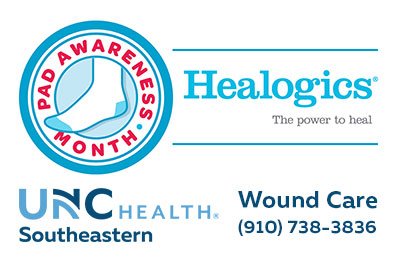Southeastern Wound Healing Center Raises Awareness of PAD

Peripheral Artery Disease (PAD) develops when the arteries that supply blood throughout the body become completely or partially blocked. This blockage by fatty plaque deposits that harden arteries is called atherosclerosis and significantly reduces blood flow. The most common type is lower-extremity PAD, where there is a reduction in blood flow to the legs and feet. When left untreated, PAD can lead to gangrene or even limb loss1.
PAD affects nearly 10 million people in the United States and increases their risks of hard-to-heal wounds and associated lower-limb amputations by obstructing circulation to the legs2. Although the long-term effects of PAD are serious, an astonishing 40 percent of people with PAD do not experience any symptoms3.
Southeastern Wound Healing Center, a member of the Healogics® network and affiliate of UNC Health Southeastern, provides specialized wound care and non-invasive tests, including the ankle-brachial index (ABI) test, which compares blood pressure in the ankles and arms to diagnose PAD, and ultrasound tests to identify which arteries are blocked.
The experts at Southeastern Wound Healing Center share the following risk factors for PAD:
- Diabetes
- High blood pressure
- High cholesterol
- Age above 65 years
- Heart disease
- Excessive weight
- Family history of PAD or arterial disease
- Smoking
Advanced PAD results in delayed wound healing and a greater risk for limb loss. Twenty-five percent of those with advanced PAD may experience an amputation within one year. People who are at risk for PAD should call Southeastern Wound Healing Center if they develop a wound. Specialized care provided by Southeastern Wound Healing Center can reduce healing times, increase healing rates and significantly lower amputation risks.
For more information on identifying PAD and treating chronic or infected wounds, contact Southeastern Wound Healing Center located at 103 W. 27th St., Lumberton or call (910) 738-3836.